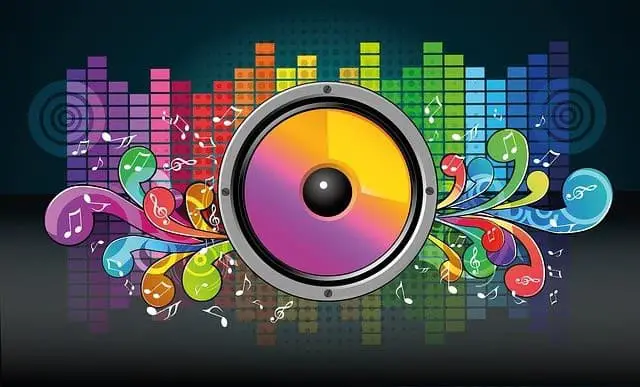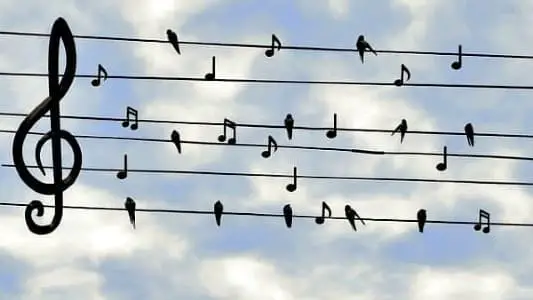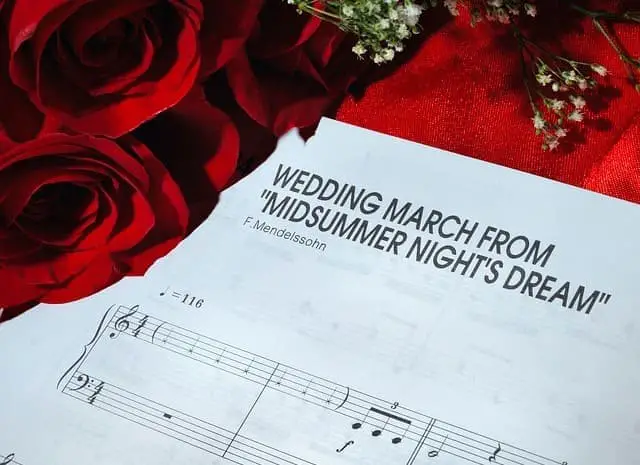- Home
- Basic Piano Theory
- Note Values
Note Values & Rests
This article may contain compensated links. Please read the disclosure for more info.
Confused about note values and rests?
Here are your answers! In this music theory lesson for beginners you'll learn how to divide the notes, and how to understand exactly how long (or short) a note or rest can be!
What a Musical Note Can Show Us
A musical note can show us two things:
- Duration: The duration, or how long or short the note is. This is also called note value.
- Pitch: When placed on a music staff, the note also shows the pitch, which means how high or low a note is.
Note values are fractions
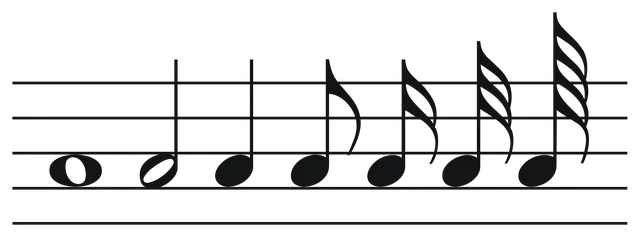 Note values from long to short. (Left to right).
Note values from long to short. (Left to right).There are two commonly used ways of naming the different notes, (US and British). Here is a comparison:
Whole note = Semibreve
Half note = Minim
Quarter note = Crotchet
Eight note = Quaver
16th note = Semiquaver
32nd note = Demisemiquaver
64th note = Hemidemisemiquaver
128th note = Semihemidemisemiquaver (Phew!😆)
The names, as you can see, indicates that they are fractions. Each note value is a part of a whole note, and that also gives them their names:
- 1 = Whole Note. We often say it lasts for 4 beats, since the most common note to count beats with is the quarter note (1/4). But this can change, since a whole note can also be counted as 2 half notes (1/2), or 8 eight notes (1/8), etc.
- 1/2 = Half Note. Usually 2 beats long.
- 1/4 = Quarter Note. Usually said to last one beat.
- 1/8 = Eight Note. 2 eight notes equals 1 quarter note.
- 1/16 = Sixteenth Note. 4 sixteenth notes equals 1 quarter note.
- 1/32 = 32nd Note. 8 32nd notes equals 1 quarter note.
- 1/64 = 64th Note. 16 64th notes equals 1 quarter note.
- 1/128 = 128th Note. 32 128th notes equals 1 quarter note.
 Note Values are Fractions
Note Values are FractionsRest Values in Music
In music there are also silences, and those are called rests. Each note value has a corresponding rest of the same length:
 Rests: Whole, Half, Quarter, 8th, 16th, 32nd and 64th rests.
Rests: Whole, Half, Quarter, 8th, 16th, 32nd and 64th rests.Parts of a Note
The different parts of a note show us how long or short the note is. The different parts are the head, the stem and the flag:

- As you could see on the charts above, longer notes are white.
- The longest whole note (let's say it lasts for 4 beats) is the simplest; only a white oval.
- The half note (2 beats) adds a stem.
- The quarter note (1 beat) also has a stem and adds color; black.
- Shorter notes, (like the one above; an 8th note =1/2 of one beat) also adds a flag to indicate that they get shorter.
- A 16th note gets two flags, a 32nd note gets three flags, and so on. The more flags, the shorter the note value.
Learn to Read Music Easier
Need more help? If you would like to learn about note reading quickly, check out this: Learn to How to Read Music in 30 Days.
The Value of Notes and Rests
So, the notes show us how many beats or parts of a beat they last. But what is a beat?
Think of it as your heart beat. All music is based on beat, and the different notes and rests symbolize how many beats, or part of a beat, they last.
However- since notes and rests are fractions, the number of beats that a note value or rest lasts can actually change, depending on what note the beat itself represents!
What will never change are the relationships between the notes and rests themselves (and their names).
Let's take a look at this note values chart:
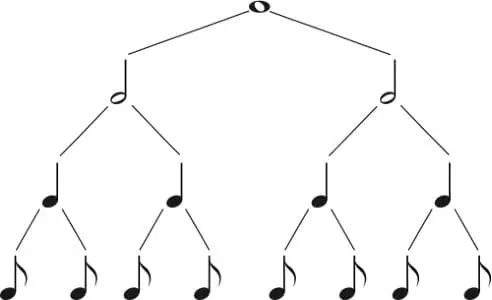
Courtesy of: Christophe Dang Ngoc Chan (cdang) / CC BY-SA (http://creativecommons.org/licenses/by-sa/3.0/)
- From the top you can see that a whole note (or rest) equals two half notes in duration.
- A half note (or rest) equals two quarter notes, etc. This will always be true.
As you start learning about music theory and playing the piano, it is usually enough to first of all understand that one beat is very often represented by a quarter note. (Just remember that this can change! Any note can be worth one beat.)
So, assuming that one quarter note equals one beat, the basic notes and rest values in music would have the following number of beats:
- Quarter note and rest = 1 beat
- Half note and rest = 2 beats
- Whole note and rest = 4 beats. (The whole rest however, has “double duty”, it is worth a whole measure of silence, whatever the time signature says.)
Continuing to divide one beat (= quarter note) in smaller fractions we get:
- 2 eight notes = one beat
- 4 sixteenth notes = one beat
- 8 thirty-second notes = one beat
- 16 sixty-fourth notes = one beat
- 32 a-hundred-twenty-eight notes = one beat.
Music Rhythm
Notes can be combined in many ways. Notes and rests are combined in patterns. These patterns are called rhythm.
Shorter note values are often grouped or beamed together, usually in groups lasting for one or two beats.
This makes it easier to read, and makes more sense when playing the music. Reading rhythm can be made easier by using rhythm syllables.
Learn to read notes and rhythm better by practicing a little every day!
Adjusting the Note Values: Triplets, Ties & Dots
You can combine the basic note values, and rests, into rhythms in any way you like.
But there are more interesting notes to spice up the music with! Some of the most common are triplets, ties and dotted notes:
Triplets

Three notes grouped together (with a "3" above like the example) are called triplets.
Usually you will see eight note triplets, but any note value can be combined as triplets.
This example is a quarter note triplet.
A simple rule of how many beats a triplet is worth is to take away one of the notes.
So three eight note triplets = two eight notes, three quarter triplets = two quarter notes, etc.
Ties
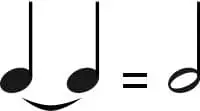
There are two ways you can adjust the duration of a note. One way is by using a tie.
Two (or more) notes with exactly the same pitch can be "tied" together, meaning that you play the note only once but keep it for the added length of all the notes that are combined.
Only notes can be tied like this, not rests.
Dotted Notes
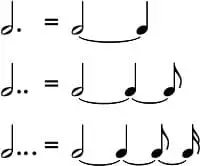
Another way to make a note value longer is to use a dot after the note. The dot prolongs the note with half of its value.
So, for example a dotted half note is worth a half note + (half its value) a quarter note.
Both notes and rests can be dotted. And you can have double, and triple dots as well!! Every dot adds half the value of the last note added.
